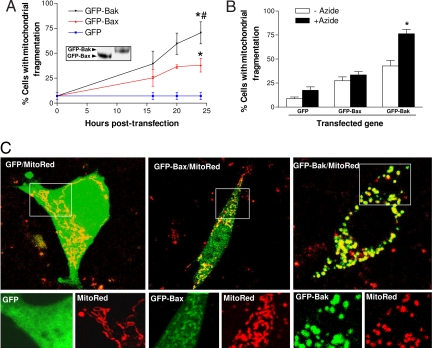Fig. 4.
Bak is more effective than Bax in restoring mitochondrial fragmentation in Bax/Bak double-knockout cells. (A) Induction of mitochondrial fragmentation by Bax or Bak transfection in Bax/Bak double-knockout (DKO) MEF cells. DKO cells were cotransfected with MitoRed and GFP, GFP-Bax, or GFP-Bak. At indicated time points, the cotransfected cells were examined by fluorescence and confocal microscopy to evaluate mitochondrial fragmentation. Data are means ± SD of five separate experiments. ∗, significantly different from GFP-transfected group; #, significantly different from GFP-Bax-transfected group. (Inset) Immunoblot analysis of GFP-Bax and GFP-Bak expression by using an anti-GFP antibody. (B) Restoration of azide-induced mitochondrial fragmentation in DKO cells by Bak but not by Bax. DKO cells were cotransfected with MitoRed and GFP, GFP-Bax, or GFP-Bak for 16 h. The cells were then incubated for another 3 h with control medium or 10 mM azide. Mitochondrial fragmentation in transfected cells was examined by fluorescence and confocal microscopy. Data are means ± SD of four separate experiments. ∗, significant difference between the treated (+Azide) and untreated (−Azide) group. (C) Representative images of MitoRed/GFP, MitoRed/GFP-Bax, and MitoRed/GFP-Bak cotransfected cells after azide treatment. Shown are transfected cells with superimposed MitoRed and GFP signals (Upper) and magnified areas with separated MitoRed and GFP signals (Lower).

